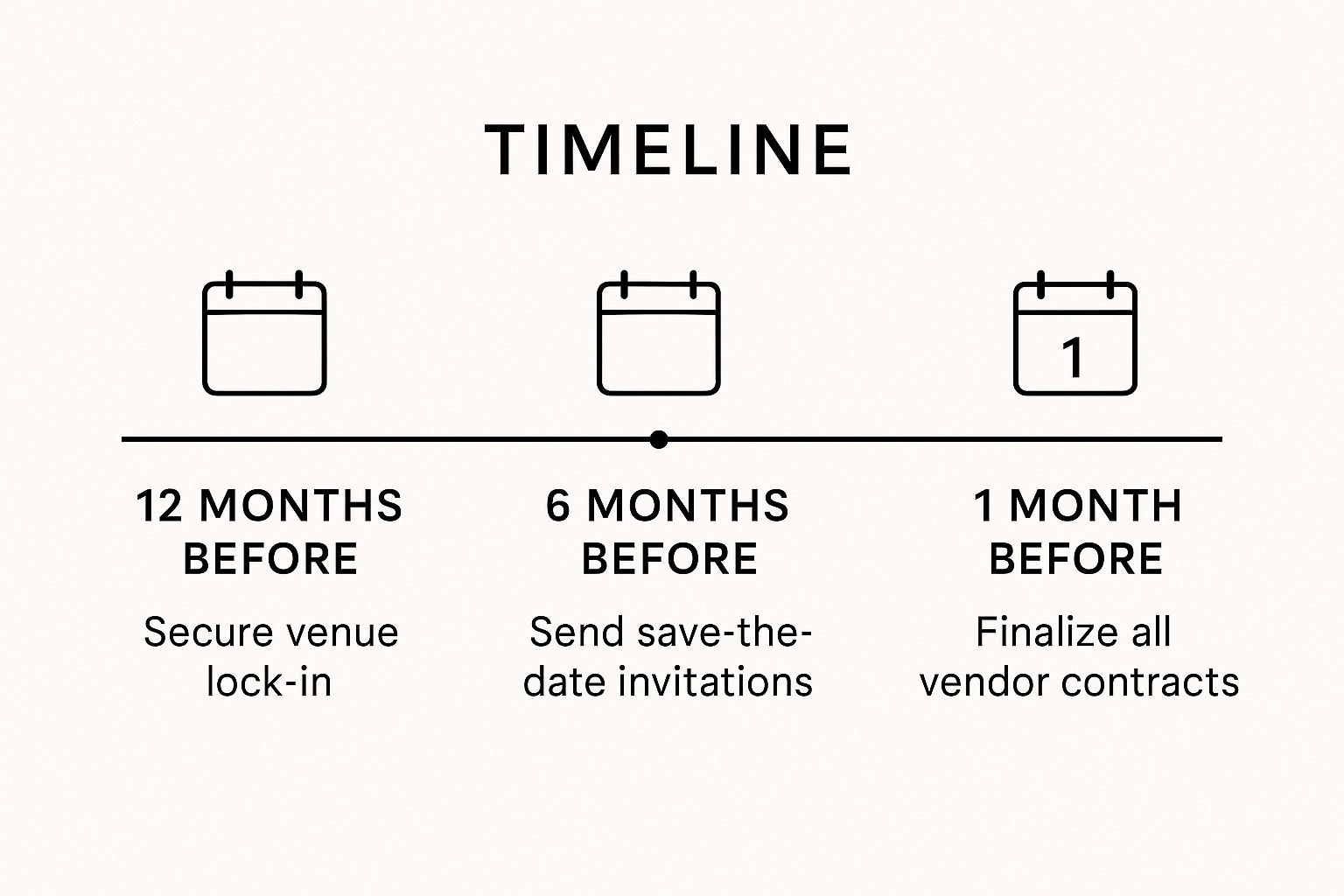Craft Unforgettable Events with Ease
Planning an event? Feeling overwhelmed? This event planning checklist simplifies the process for any occasion, from weddings and corporate events to private parties and charity fundraisers. We'll guide you through eight essential steps, ensuring you stay organized and on budget while creating a truly memorable experience. Learn how to define goals, manage your budget, secure the perfect venue, create a timeline, coordinate vendors, market your event, manage logistics, and even evaluate success afterward. Follow this event planning checklist and transform your vision into reality.
1. Define Event Goals and Objectives
Kicking off your event planning checklist? The very first thing – and arguably the most important – is defining your event goals and objectives. This is the bedrock of your entire event. It's about figuring out the why behind your event, what you want to achieve, and how you'll measure success. Are you aiming to raise a certain amount of money for a cause? Hoping to boost your brand's visibility? Maybe you just want to throw an unforgettable birthday bash. Whatever the reason, clearly defined objectives will steer every single decision you make from here on out, making it an essential part of any event planning checklist.

Think of your objectives as your event's compass. They'll keep you on track and prevent you from getting lost in the weeds of endless details. This step is critical for everyone, from couples planning their dream wedding to corporate event managers orchestrating a massive product launch, charity event coordinators hitting fundraising targets, or even someone planning a smaller private party and wanting a photo booth.
Using the SMART goal framework is a fantastic way to approach this. Make sure your objectives are Specific, Measurable, Achievable, Relevant, and Time-bound. Instead of a vague goal like "have a great party," aim for something concrete like "achieve 90% attendee satisfaction as measured by post-event surveys." Thinking about budget early on is also important. Your goals will directly impact how much you spend and where those funds are allocated. Identifying your target audience is just as crucial. Who are you trying to reach? What are their interests and expectations? Knowing this helps tailor the event and its messaging for maximum impact. Finally, consider your Key Performance Indicators (KPIs). These are the metrics you'll use to track progress and measure success against your objectives.
Features of this step include:
- SMART goal framework: Ensuring objectives are well-defined and actionable.
- Budget considerations: Linking goals to financial planning.
- Target audience identification: Focusing the event on the right people.
- Key performance indicators (KPIs): Measuring the success of the event.
Pros:
- Provides laser-sharp direction for all planning decisions.
- Helps justify expenses and resource allocation.
- Creates alignment among all stakeholders (clients, vendors, team members).
- Simplifies post-event evaluation.
Cons:
- Might require negotiation among different stakeholders with potentially competing priorities.
- Goals may need adjustments as the planning process unfolds.
Examples:
- Fundraising Gala: "Raise $100,000 for cancer research from 250 attendees."
- Product Launch: "Generate 50 qualified sales leads and secure media coverage in 3 industry publications."
- Wedding: "Host a memorable and stress-free wedding celebration for 150 guests within a budget of $30,000."
Actionable Tips:
- Document everything: Write down your goals and get sign-off from key stakeholders.
- Prioritize: If you have multiple goals, determine which ones are most important.
- Stay flexible: Revisit your goals throughout the planning process to ensure they're still aligned with your overall vision.
- Craft a mission statement: Create a simple, memorable mission statement that captures the essence of your event.
This first step in the event planning checklist is popularized by event planning gurus like David Tutera and corporate event management giants like Freeman and MCI. They know that a well-defined objective is the cornerstone of any successful event. This is why it deserves its place at the very top of your event planning checklist.
2. Create a Comprehensive Budget
Crafting a rock-solid budget is absolutely crucial for any successful event, whether it's a small birthday bash or a large corporate conference. Think of your budget as the financial roadmap for your event planning checklist. It helps you keep track of all your expenses, anticipate potential costs, and avoid any nasty financial surprises down the road. This means less stress and more celebrating when the big day arrives! A well-structured budget breaks down all anticipated costs and potential revenue streams into specific categories, allowing you to see exactly where your money is going. Common categories include venue rental, catering, entertainment, marketing and promotion, staffing, technology rentals (like sound systems or projectors), and, importantly, a contingency fund.

This detailed approach involves listing every single expense, from the big-ticket items like the venue down to the smaller details like printing invitations. You'll also want to factor in potential revenue sources, if applicable, such as ticket sales or sponsorships. A good budget also includes a cash flow timeline so you know when payments are due, and allocates a contingency fund (usually 10-15% of your total budget) for those unexpected hiccups that inevitably pop up. This ensures you're covered if the DJ cancels last minute or the flower delivery gets delayed.
Features of a Comprehensive Budget:
- Line-item expense categories: Breaking down expenses helps you see where your money is going.
- Revenue tracking (if applicable): Track ticket sales, sponsorships, or other income.
- Cash flow timeline: Know when payments are due to avoid late fees or penalties.
- Contingency allocations (10-15%): A financial safety net for unexpected expenses.
Pros:
- Prevents overspending: Sets clear financial boundaries.
- Identifies cost-saving opportunities: Highlights areas where you can trim expenses.
- Facilitates financial accountability: Keeps you on track and responsible for your spending.
- Provides historical data: Useful for planning future events.
Cons:
- Time-consuming to create: Requires research and careful planning.
- Requires regular monitoring and updating: Your budget is a living document, not a static one.
- May expose funding shortfalls: Early identification allows you to adjust plans or seek additional funding.
Examples:
- Corporate Conference: 40% venue/catering, 20% speakers/content, 15% technology, 10% marketing, 15% staff/miscellaneous.
- Wedding: 40-50% venue/catering, 10-15% photography/videography, 10-15% attire/flowers.
Tips for Creating a Killer Budget:
- Research actual costs: Don't just guess! Get quotes from multiple vendors for accurate pricing.
- Build in that 10-15% contingency fund: Trust us, you'll thank yourself later.
- Use spreadsheet templates with formulas: This makes tracking running totals a breeze.
- Compare quotes from multiple vendors: Shop around for the best deals.
- Review and update the budget weekly: Keep your budget current as your plans evolve.
Software like Planning Pod and Eventbrite Organizer, along with industry standards like The Events Industry Council's APEX standards, have popularized and streamlined the budget creation process. A well-defined budget is essential for everyone involved in event planning, from couples planning their weddings to corporate event managers organizing large-scale conferences, and even those planning smaller private parties. It's the cornerstone of a successful and stress-free event planning process.
3. Select and Secure the Venue
Picking the perfect spot for your event is a big deal in your event planning checklist. Think of it as the foundation upon which everything else is built. It influences almost every other decision, from when you can hold the event to what kind of vibe it gives off, and even how much fun your guests have. Your chosen venue needs to reflect your event's theme, comfortably fit everyone on your guest list, offer the amenities you need (think Wi-Fi, restrooms, etc.), be accessible to all attendees, and, of course, not break the bank. Locking down the venue is usually one of the first and most crucial steps in the entire planning process.

This step deserves its place high on the event planning checklist because it sets the stage, literally. It dictates the atmosphere, influences the logistics, and significantly impacts the overall experience. Here's a closer look at the key features to consider:
- Location and Accessibility: Is it easy to get to? Is there ample parking or public transport nearby? Is the venue accessible for guests with disabilities?
- Capacity and Layout Options: Can the space comfortably accommodate your expected headcount? Does it offer flexible layout options for different event formats (e.g., theater style, banquet rounds, cocktail reception)?
- Available Dates: Does the venue have availability that aligns with your desired timeframe? Popular venues often book up far in advance.
- In-house Services: Does the venue offer services like audio-visual equipment, catering, or event coordination? Bundled services can simplify planning and potentially save money.
- Restrictions and Regulations: Are there any restrictions on décor, vendors, or noise levels? Knowing these upfront is essential.
- Insurance Requirements: Does the venue require you to carry event insurance? What are the coverage requirements?
Pros of Securing the Right Venue:
- Sets the Tone: From a rustic barn to a chic hotel ballroom, the venue sets the overall atmosphere and aesthetic of your event.
- Simplified Planning: Many venues offer bundled services, including catering, AV equipment, and even event planning assistance, which can streamline the process.
- Experienced Staff: Established venues often have experienced staff who understand event logistics and can provide valuable support.
Cons to Keep in Mind:
- Booking in Advance: Highly sought-after venues may require booking 6-18 months in advance, especially for peak seasons.
- Vendor Policies: Some venues have strict policies regarding outside vendors, potentially limiting your choices for catering, photography, or other services.
- Hidden Fees: Be aware of potential hidden fees like service charges, overtime charges, or cleaning fees, which can impact your budget.
- Weather Considerations (Outdoor Venues): If you're considering an outdoor venue, have a backup plan in case of inclement weather.
Examples of Successful Venue Selection:
- Elegant Gala: The Plaza Hotel in New York City is a classic choice for upscale galas and weddings.
- Large-Scale Trade Show: McCormick Place in Chicago provides the vast, flexible space needed for large conventions and trade shows.
- Unique Experience: Museums or botanical gardens can create memorable experiences for corporate events, private parties, or even weddings.
Actionable Tips for Securing Your Venue:
- Visit in Person: Always visit multiple venues in person to get a feel for the space, assess the layout, and meet the staff.
- Ask About Fees: Inquire about all potential fees upfront, including service charges, overtime charges, and cancellation policies.
- Review the Contract Carefully: Thoroughly review the venue contract before signing, paying close attention to cancellation policies, insurance requirements, and any restrictions.
- Confirm Logistics: Confirm load-in/load-out times and restrictions, especially if you're bringing in outside vendors.
- Transportation and Parking: Consider transportation and parking availability for your attendees.
Whether you're planning a wedding, a corporate event, a private party, or a charity fundraiser, selecting and securing the right venue is paramount to your event's success. Platforms like Cvent and VenueBook, often used by destination management companies like PRA and Allied PRA, can help you find and compare venues in your desired location. Remember, the right venue can transform your event from ordinary to extraordinary.
4. Develop a Detailed Timeline
Creating a detailed timeline is absolutely essential for any successful event, no matter the size. Think of it as your event's roadmap, guiding you from the initial brainstorming session all the way to post-event wrap-up. This crucial step in your event planning checklist prevents last-minute scrambles and ensures everything runs smoothly. A well-structured timeline breaks down all tasks, assigns responsibilities, and sets deadlines, making sure everyone is on the same page and nothing falls through the cracks.

This infographic visualizes the flow of event planning, highlighting key milestones along the way from initial idea to post-event activities. Notice how each stage builds upon the previous one, emphasizing the importance of a sequential and organized approach.
Features like task categorization, deadline specifications, and assigning responsibility make managing even the most complex events much easier. Identifying dependencies between tasks – knowing that you can't send invitations before finalizing the guest list, for example – and highlighting the critical path (the sequence of tasks that determine the overall project duration) are also crucial for effective planning. This detailed approach helps manage stakeholder expectations and provides clear accountability, eliminating any confusion about who’s doing what and when.
Let's look at some examples. For a wedding, your timeline might start a year or more in advance with venue selection and end a couple of months after the big day with sending thank-you notes. Corporate events often have marketing milestones incorporated into the timeline, like sending "Save the Dates" 3-6 months prior and opening registration 2-3 months prior. Whether you're planning a small birthday party or a large-scale charity gala, the principle remains the same: a detailed timeline is your best friend.
While incredibly useful, timelines do require upkeep. Regular updates and monitoring are essential to accommodate any changes or unexpected delays. For large-scale events, timelines can become complex, so utilizing project management software like Asana or Monday.com can be a lifesaver. These tools, popularized by project management methodologies like PMBOK (Project Management Body of Knowledge), help streamline the process and keep everything organized.
Here are a few tips to create a killer timeline:
- Work backward: Start from your event date and work backward, scheduling tasks in reverse order.
- Buffer time: Include buffer time for unexpected delays. Things will inevitably pop up, and this padding will keep you from getting derailed.
- Regular reviews: Schedule regular timeline review meetings with your team to discuss progress and make necessary adjustments.
- Color-coding: Use color-coding for different departments, task types, or priority levels to make your timeline visually clear.
- Multiple timelines: Create both a master planning timeline and a detailed day-of timeline to cover all bases.
This approach deserves a prominent place in any event planning checklist because it offers immense benefits. From preventing last-minute rushes and oversights to coordinating activities between multiple team members and vendors, a detailed timeline is the cornerstone of successful event execution. While it requires ongoing management and accurate time estimations, the pros far outweigh the cons. By investing the time upfront to build a robust timeline, you'll save yourself stress and headaches down the line, ensuring your event goes off without a hitch.
5. Coordinate Vendors and Suppliers
Coordinating vendors and suppliers is a crucial step in any event planning checklist, whether you're organizing a small birthday party or a large corporate conference. It's the backbone of bringing your vision to life, and honestly, it can make or break your event. This step involves everything from finding the right caterer to making sure the DJ knows exactly when to play the first dance. Let's dive in.
This process essentially means researching, selecting, and managing all the external service providers who will contribute to your event. Think catering, audiovisual equipment, decor, entertainment (like a photo booth!), photography, transportation, and even staffing. Effective vendor coordination ensures everyone is on the same page, knows their responsibilities, and understands the timeline. This is key for a smooth, stress-free event.
Why is this on the event planning checklist? Because without it, you'll be juggling a million different contacts, contracts, and details. This step streamlines communication and ensures everyone is working towards the same goal: making your event amazing.
Features of Vendor Coordination:
- Vendor Selection Process: Finding vendors that fit your event's style, budget, and needs.
- Contract Negotiation: Hammering out the details and getting everything in writing.
- Communication Protocols: Establishing clear communication channels and schedules.
- Performance Expectations: Clearly outlining what you expect from each vendor.
- Payment Schedules: Setting up payment milestones and ensuring timely payments.
- Delivery/Setup Logistics: Coordinating delivery times, setup locations, and teardown processes.
Pros:
- Access to Specialized Expertise: You get to leverage the skills and knowledge of professionals.
- Delegation of Technical Aspects: Focus on the big picture while experts handle the details.
- Potential for Package Discounts: Some vendors offer discounts when you bundle services.
- Reduced Equipment Investment: No need to buy expensive equipment you'll only use once.
Cons:
- Requires Thorough Vetting: You need to do your research to ensure vendors are reliable.
- Communication Challenges: Keeping everyone on the same page can be tricky.
- Potential for Scope Creep: Be clear about your needs to avoid unexpected charges.
Examples of Successful Vendor Coordination:
- Large Corporate Events: Destination Management Companies (DMCs) are often used to coordinate local vendors, simplifying logistics for large-scale events.
- Weddings: Wedding planners often maintain preferred vendor lists based on past performance, ensuring quality and reliability.
Actionable Tips for Coordinating Vendors:
- Create detailed specifications: Tell each vendor exactly what you need.
- Request and contact references: Don't just take their word for it – check their track record.
- Develop a master contact sheet: Keep all vendor information in one place.
- Schedule pre-event walk-throughs: Especially important for venues and key vendors.
- Clarify insurance and liability requirements: Protect yourself and your event.
- Consider backup options: Have a plan B, especially for critical vendors like caterers or photographers.
When to Use This Approach:
Always! Whether it’s a small gathering or a large-scale production, coordinating your vendors is a non-negotiable part of the event planning checklist.
Who Should Use This Approach:
- Couples planning weddings
- Corporate event managers
- Hosts of private parties
- Charity event coordinators
- Creative event planners
- Anyone planning an event, even if it's just renting a photo booth!
By following these tips and making vendor coordination a priority in your event planning checklist, you'll be well on your way to a successful and stress-free event. Remember, clear communication, thorough planning, and careful vendor selection are the keys to a flawlessly executed event.
6. Design Marketing and Communication Plan
A killer marketing and communication plan is the backbone of any successful event, whether you're planning a small birthday bash or a massive corporate conference. This crucial step in your event planning checklist ensures you reach the right people, generate buzz, and ultimately, get those RSVPs rolling in (or tickets sold!). It's about creating a cohesive experience from the initial save-the-date to the post-event thank you, managing expectations, and keeping attendees informed and engaged every step of the way.
This multi-faceted approach considers everything from understanding your target audience to leveraging the right communication channels. For a public event like a concert or festival, this translates to driving ticket sales and registrations. For private events like weddings or corporate gatherings, it's about managing the attendee experience and ensuring everyone is on the same page.
Features of a Solid Plan:
- Target audience analysis: Who are you trying to reach? What are their interests and preferences? Knowing this will inform your messaging and channel selection.
- Branding and visual identity: A consistent look and feel across all your materials creates a professional and memorable experience. Think logos, color schemes, fonts, and overall design.
- Promotional timeline: Map out when and how you'll communicate with your attendees, from initial announcements to last-minute reminders.
- Multi-channel strategy: Don't put all your eggs in one basket. Use a mix of email, social media, website updates, and even traditional print materials to reach your audience where they are.
- Registration/ticketing system: A smooth and efficient registration process is essential for managing attendance and gathering important attendee data. When setting this up, explore the options available. Streamline your event registration and feedback collection process by utilizing free online form builders. These tools offer user-friendly interfaces and customizable templates to create engaging forms for attendees. This resource, 7 Typeform Alternative Free: Top Form Builders in 2025 from BuildForm, offers a comprehensive overview.
- Attendee communications: Keep attendees informed with regular updates, reminders, and important information.
- Media relations (if applicable): For larger events, engaging with the media can boost visibility and generate excitement.
Pros:
- Builds anticipation and excitement: A well-executed marketing plan generates buzz and gets people looking forward to your event.
- Controls information flow to attendees: You're in charge of the narrative, ensuring attendees receive accurate and timely information.
- Creates consistent attendee experience: Consistent branding and communication contribute to a seamless and professional event experience.
- Captures data for future events: Gathering attendee information through registration and feedback forms provides valuable insights for planning future events.
Cons:
- Requires significant lead time: Developing and implementing a comprehensive marketing plan takes time and effort.
- May need specialized skills (graphic design, copywriting): You might need to outsource certain tasks if you lack in-house expertise.
- Effectiveness can be difficult to measure: Quantifying the impact of your marketing efforts can be challenging.
- Channel preferences vary by demographic: What works for one audience might not work for another. Understanding your target demographic is key.
Examples of Successful Implementation:
- SXSW: The annual South by Southwest festival employs year-round marketing efforts, with peak activity 3-6 months before the event.
- Internal corporate events: Many companies use targeted email campaigns with staged information releases to keep employees informed and engaged.
- TED Conference: TED leverages exclusivity and a highly curated speaker lineup to create demand and generate buzz around their events.
Actionable Tips:
- Develop a consistent visual identity across all materials. This strengthens your brand and creates a cohesive experience for attendees.
- Create a content calendar for scheduled communications. This ensures you stay on track and deliver timely information.
- Use segmentation to deliver relevant messages to different attendee types. Tailoring your messaging to specific groups increases engagement and relevance.
- Leverage speakers, sponsors, and partners in promotional efforts. Extend your reach by tapping into their networks.
- Consider attendee journey mapping to identify key communication points. Understanding the attendee experience helps you deliver the right information at the right time.
Popularized By: Social media platforms, Event apps like Whova and Attendify, and Marketing automation platforms like Marketo and Hubspot.
This item deserves its place on the event planning checklist because, without effective marketing and communication, even the most meticulously planned event can fall flat. It's the key to reaching your target audience, generating excitement, and ensuring a successful and memorable experience for everyone involved.
7. Plan Event Logistics and Flow
This is where the rubber meets the road in your event planning checklist! Planning event logistics and flow is all about orchestrating the how of your event. Think of it as designing the attendee journey from the moment they arrive until they depart. It’s about making sure everything runs smoothly behind the scenes so your guests can relax and enjoy themselves. Trust us, nailing this step is crucial for a successful event, no matter what kind you're planning – from a small birthday bash to a large corporate conference.
So, what does this involve? Essentially, it’s about mapping out everything physical and operational:
- Floor plan and space allocation: Where will everything go? How will you maximize the space you have?
- Traffic flow analysis: How will people move through the venue? Where are the potential bottlenecks?
- Equipment and supply inventory: Do you have enough chairs, tables, microphones, etc.? Where will they be stored and how will they get set up?
- Setup and breakdown schedules: Who’s doing what, and when? How long will it take to set up and break down everything?
- Staffing plans: How many staff members do you need? What are their roles and responsibilities?
- Accessibility considerations: Can everyone access all areas of the venue, regardless of ability?
- Risk assessment and contingency planning: What could go wrong, and what's your plan B? (Because let's be real, something always goes wrong.)
Why is this so important for your event planning checklist? Because well-executed logistics are practically invisible to attendees, but they’re the backbone of a successful event. Think of it like the engine of a car – you don’t see it, but without it, you’re not going anywhere!
Examples of Successful Implementation:
- Trade shows: These events often create designated paths through exhibition areas to maximize vendor exposure and prevent attendee overwhelm.
- Festivals: RFID wristbands are increasingly popular at festivals, allowing for quick and easy entry, cashless purchases, and even tracking attendee engagement.
- Conferences: Scheduled session breaks not only provide attendees with much-needed coffee refills but also allow for movement between sessions and networking opportunities.
Actionable Tips for Smoother Logistics:
- Create detailed floor plans to scale: Don't just sketch it out on a napkin! Use online tools or graph paper to create accurate floor plans that show exactly where everything will go.
- Use timed entry for large events: Staggering arrival times can prevent a massive rush at the entrance and help maintain a steady flow throughout the event.
- Consider flow patterns: Think strategically about where you place high-traffic elements like bars, registration desks, and photo booths.
- Plan for accessible routes: Ensure that all areas of the venue are accessible to attendees with disabilities.
- Conduct a walkthrough: Visualize the entire attendee experience from start to finish. This will help you identify potential issues before the big day.
- Create detailed setup instructions with photos: This is especially helpful for volunteers or staff who may not be familiar with the venue.
Pros:
- Prevents bottlenecks and congestion
- Ensures efficient use of space and resources
- Improves attendee experience
- Reduces day-of stress (a LOT of it!)
Cons:
- Requires detailed advance planning (but it’s worth it!)
- May need venue-specific expertise
- Must accommodate last-minute changes (flexibility is key!)
Popularized by: Event diagramming software like Social Tables and AllSeated, crowd management experts like Steve Adelman, RFID and event technology companies like Eventbrite and Boomset.
Whether you’re planning a wedding, corporate event, private party, or charity gala, strong event logistics and flow are absolutely essential to its success. By taking the time to plan these details carefully, you can ensure that your event runs smoothly and your attendees have a fantastic experience.
8. Create Post-Event Evaluation Strategy
So, you pulled off your event! Congrats! But before you collapse in a heap of confetti and exhaustion, there's one crucial step left: the post-event evaluation. Think of it as the after-action report for your awesome party, conference, wedding, or whatever shindig you just orchestrated. This step is essential for any event planning checklist, whether you're a seasoned corporate event manager or a couple planning their dream wedding.
This isn't just about patting yourself on the back (although that's definitely allowed!). A post-event evaluation is a systematic way to collect, analyze, and apply feedback to understand what worked, what didn't, and how to make your next event even better. It’s how you learn and grow as an event planner, prove your value, and justify future event investments.
How it Works:
A robust post-event evaluation strategy uses both quantitative data (hard numbers) and qualitative feedback (people's opinions and experiences). It involves gathering information from multiple sources, including:
- Success Metrics Tied to Original Objectives: Did you hit your targets? If your goal was to generate 100 qualified leads at a corporate event, did you achieve that? If you were fundraising, how much did you raise versus your target? These metrics directly reflect the effectiveness of your event.
- Attendee Feedback Mechanisms: Surveys, feedback forms (digital or paper), social media monitoring, and even casual conversations can offer valuable insights. Did attendees enjoy the event? What did they find most valuable? What could be improved? Tools like SurveyMonkey, Typeform, Slido, and Mentimeter can make collecting this data a breeze.
- Vendor Performance Assessment: How did your caterer, DJ, photographer, venue, and other vendors perform? Were they on time, professional, and within budget? Their performance significantly impacts the overall event experience.
- Financial Reconciliation: Crunch the numbers. Compare actual expenses against your budget. Understanding your spending helps you optimize your budget for future events.
- Team Debrief Process: Gather your team for a post-mortem. Discuss what went smoothly, what challenges arose, and how to streamline processes in the future.
- Documentation Standards: Keep detailed records of everything! This creates institutional knowledge that you can refer back to when planning your next event.
- Follow-Up Communications Plan: Thank attendees, vendors, and sponsors. Share key findings from your evaluation and hint at exciting things to come for future events.
Examples:
- Corporate Events: Track metrics like qualified leads generated, sales influenced, website traffic, and press mentions.
- Fundraising Events: Measure total dollars raised, cost per dollar raised, and donor acquisition cost.
- Weddings: Gauge guest satisfaction with the venue, catering, music, and overall ambiance. Collect feedback on what made the day special.
- Educational Events: Assess learning outcomes, knowledge retention, and participant engagement.
Pros:
- Provides data-driven insights for improvement
- Demonstrates accountability to stakeholders
- Creates institutional knowledge
- Helps justify future event investments
- Identifies successful elements worth repeating
Cons:
- Survey fatigue can limit response rates
- Qualitative feedback can be difficult to quantify
- May reveal shortcomings requiring difficult conversations
Actionable Tips:
- Design surveys to be brief and specific. Nobody wants to spend 30 minutes filling out a feedback form.
- Use a mix of rating scales and open-ended questions to gather both quantitative and qualitative data.
- Collect feedback while the event is fresh in everyone's minds (ideally within 24-48 hours).
- Share key findings with stakeholders and team members. Transparency builds trust and fosters collaboration.
- Document successful strategies and lessons learned. Create a "best practices" document for future events.
- Schedule a formal debrief meeting with your team within one week of the event.
- Compare results against your original goals and KPIs to measure your success.
Why This Deserves a Place in the Event Planning Checklist:
Simply put, post-event evaluation closes the loop on your event planning process. It transforms a one-time event into a learning opportunity, allowing you to continuously improve and deliver increasingly successful events in the future. Whether you're planning a small private party or a large-scale corporate conference, this step is vital for maximizing your ROI and building a reputation for excellence.
8-Step Event Planning Checklist Comparison
| Task / Checklist Item | 🔄 Implementation Complexity | 🛠️ Resource Requirements | ⭐ Expected Outcomes | 🎯 Ideal Use Cases | ⚡ Key Advantages |
|---|---|---|---|---|---|
| Define Event Goals and Objectives | Low to Medium: Requires stakeholder alignment and negotiation | Moderate: Time for meetings and research | Clear direction, aligned objectives, measurable success 📊 | All event types needing focus and clarity | Provides clarity and simplifies evaluation 💡 |
| Create a Comprehensive Budget | Medium: Detailed, ongoing updates needed | High: Requires financial data and monitoring | Prevents overspending, financial control 📊 | Events with strict financial management | Helps identify cost savings and accountability ⚡ |
| Select and Secure the Venue | Medium to High: Early booking, contract review | High: Site visits, negotiation, contracts | Sets event tone, ensures capacity and amenities ⭐ | Events dependent on venue availability | Bundled services, experienced venue staff 💡 |
| Develop a Detailed Timeline | Medium: Requires task breakdown and coordination | Moderate: Planning tools and team input | Prevents oversight, ensures deadlines ⭐ | Complex/multi-stakeholder events | Provides accountability and coordination ⚡ |
| Coordinate Vendors and Suppliers | Medium to High: Coordination of multiple parties | High: Vendor research, contracts, communication | Access to expertise, smooth operations ⭐ | Events requiring specialized services | Delegation and potential cost savings 💡 |
| Design Marketing and Communication Plan | Medium to High: Multi-channel, strategic planning | High: Skills in design, copywriting, tools | Builds audience interest and attendance ⭐ | Public or large audience-focused events | Consistent messaging and data capture ⚡ |
| Plan Event Logistics and Flow | High: Detailed spatial and operational planning | High: Venue knowledge, staff, equipment | Efficient event operation, improved experience ⭐ | Large-scale or complex on-site events | Reduces bottlenecks, smooth attendee flow 💡 |
| Create Post-Event Evaluation Strategy | Medium: Data collection and analysis | Moderate: Survey tools, team time | Data-driven insights, ROI measurement ⭐ | All events requiring feedback and improvement | Captures lessons learned, stakeholder accountability ⚡ |
Elevate Your Next Event with 1021 Events
From defining your event goals and setting a realistic budget to securing the perfect venue and coordinating vendors, mastering the elements of a comprehensive event planning checklist is key to throwing a truly unforgettable event. Remember, a well-structured plan keeps you organized, on track, and stress-free, allowing you to enjoy the journey as much as the destination. By following the steps outlined in this article—from crafting a detailed timeline to developing a post-event evaluation strategy—you’re setting the stage for a seamless and successful event, no matter the size or scope. Whether you're planning an intimate wedding, a large-scale corporate function, or a vibrant charity gala, these core principles are your foundation for success.
Taking the time to thoroughly plan your event is an investment in its overall impact. A well-executed event strengthens relationships, builds community, and creates lasting memories. It's about more than just logistics; it's about bringing your vision to life and leaving a positive impression on everyone involved.
Ready to turn your dream event into a reality and take it to the next level? 1021 Events seamlessly integrates into your event planning checklist, providing expert support and resources to enhance every aspect of your special occasion. Visit 1021 Events today to explore how we can help you elevate your next event with dynamic DJ services, stunning lighting, and cutting-edge technology.




